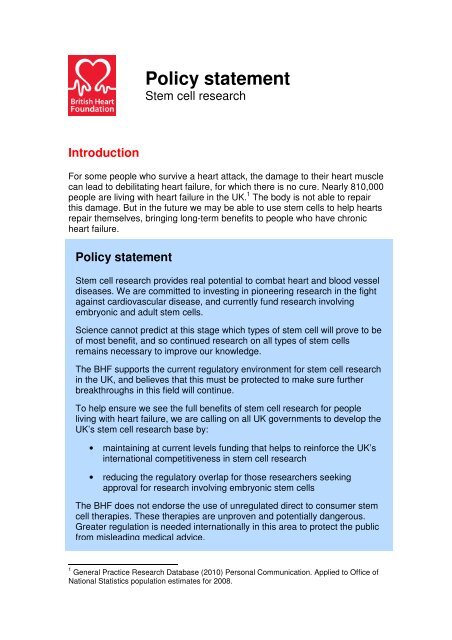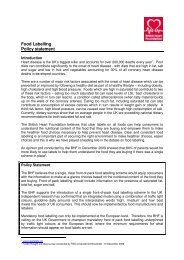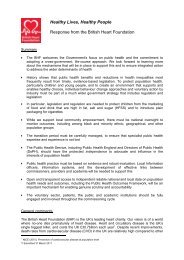Stem cell policy statement April 2011 - British Heart Foundation
Stem cell policy statement April 2011 - British Heart Foundation
Stem cell policy statement April 2011 - British Heart Foundation
You also want an ePaper? Increase the reach of your titles
YUMPU automatically turns print PDFs into web optimized ePapers that Google loves.
Policy <strong>statement</strong><strong>Stem</strong> <strong>cell</strong> researchIntroductionFor some people who survive a heart attack, the damage to their heart musclecan lead to debilitating heart failure, for which there is no cure. Nearly 810,000people are living with heart failure in the UK. 1 The body is not able to repairthis damage. But in the future we may be able to use stem <strong>cell</strong>s to help heartsrepair themselves, bringing long-term benefits to people who have chronicheart failure.Policy <strong>statement</strong><strong>Stem</strong> <strong>cell</strong> research provides real potential to combat heart and blood vesseldiseases. We are committed to investing in pioneering research in the fightagainst cardiovascular disease, and currently fund research involvingembryonic and adult stem <strong>cell</strong>s.Science cannot predict at this stage which types of stem <strong>cell</strong> will prove to beof most benefit, and so continued research on all types of stem <strong>cell</strong>sremains necessary to improve our knowledge.The BHF supports the current regulatory environment for stem <strong>cell</strong> researchin the UK, and believes that this must be protected to make sure furtherbreakthroughs in this field will continue.To help ensure we see the full benefits of stem <strong>cell</strong> research for peopleliving with heart failure, we are calling on all UK governments to develop theUK’s stem <strong>cell</strong> research base by:• maintaining at current levels funding that helps to reinforce the UK’sinternational competitiveness in stem <strong>cell</strong> research• reducing the regulatory overlap for those researchers seekingapproval for research involving embryonic stem <strong>cell</strong>sThe BHF does not endorse the use of unregulated direct to consumer stem<strong>cell</strong> therapies. These therapies are unproven and potentially dangerous.Greater regulation is needed internationally in this area to protect the publicfrom misleading medical advice.1 General Practice Research Database (2010) Personal Communication. Applied to Office ofNational Statistics population estimates for 2008.
Policy <strong>statement</strong> – <strong>Stem</strong> <strong>cell</strong> researchBackground<strong>Stem</strong> <strong>cell</strong>s are immature <strong>cell</strong>s in the body that exist to replace our old <strong>cell</strong>s when weneed new ones. They are pluripotent, meaning they are capable of developing into avariety of different types of specialised <strong>cell</strong>. Their versatility presents an excitingavenue for research whereby damaged tissue could potentially be replaced withhealthy, functioning tissue – a process known as regenerative medicine.For many heart patients, this could mean that in the future heart tissue could berepaired using replacement <strong>cell</strong>s grown from stem <strong>cell</strong>s. This field of research showssimilar promise in other conditions such as Alzheimer’s disease, diabetes andParkinson’s disease.The main types of stem <strong>cell</strong> commonly used in research are:• embryonic stem <strong>cell</strong>s, which exist within early embryos and are the mostpluripotent, capable of differentiating into any <strong>cell</strong> in the body• adult stem <strong>cell</strong>s, which exist in the body after birth and can only develop intoa limited range of mature <strong>cell</strong> types• induced pluripotent stem <strong>cell</strong>s, which are adult <strong>cell</strong>s that have beenartificially made to take on the qualities of embryonic stem <strong>cell</strong>s• umbilical cord blood stem <strong>cell</strong>s, which contain several types of adult stem<strong>cell</strong>s and can be collected, frozen and stored in cord blood banks after birth.To maximise the potential of stem <strong>cell</strong>s, research into both adult and embryonic stem<strong>cell</strong>s must be carried out. 2 By studying embryonic stem <strong>cell</strong>s we will eventuallyunderstand their molecular properties and apply this knowledge to adult stem <strong>cell</strong>sfor the development of treatments. Research using adult stem <strong>cell</strong>s holds greatpromise because the patient’s own <strong>cell</strong>s might be used to repair damaged tissues.Past studies in animals have shown that stem <strong>cell</strong>s can improve the function of adamaged heart. By improving our knowledge about the chemicals, genes, <strong>cell</strong>s andtissues involved in repairing the heart, this could be ultimately translated intohumans. To gain this fundamental understanding, we need to establish how toisolate and identify stem <strong>cell</strong>s in the adult, how to stimulate them to turn into the <strong>cell</strong>swe want, and how to make them incorporate and function safely and successfully aspart of a tissue or organ.<strong>Stem</strong> <strong>cell</strong>s may also become more important in future drug development. Cellcultures grown from human stem <strong>cell</strong>s could be useful for testing the safety andeffectiveness of new drugs before they are given to people. A public-privateconsortium, <strong>Stem</strong> Cells for Safer Medicines, has been set up with the aim of helpingto develop stem <strong>cell</strong> models for drug screening. 3 These developments may help toreduce the number of animals used in medical research. We may in the future alsobe able to improve the safety of new drugs by using stem <strong>cell</strong>s from humans to studyany potential toxicity.Science cannot predict at this stage which types of stem <strong>cell</strong> will prove to be of mostbenefit, and so continued research on all types of stem <strong>cell</strong>s remains necessary toimprove our knowledge. 42 House of Lords Science and Technology Committee Report on <strong>Stem</strong> Cell Research (2002)3 www.sc4sm.org4 European Science <strong>Foundation</strong> (2010): Human <strong>Stem</strong> Cell Research and Regenerative Medicine2
Policy <strong>statement</strong> – <strong>Stem</strong> <strong>cell</strong> research<strong>Stem</strong> <strong>cell</strong> research in the UKThe UK has been a leader in stem <strong>cell</strong> research since the 1970s, when the firstmouse embryonic stem <strong>cell</strong> was isolated. Since 2000, a number of developmentshave advanced the stem <strong>cell</strong> research environment to help to develop this worldleadingposition.In 2002 the UK <strong>Stem</strong> Cell Bank was created, the world’s first such institute, to holdhigh quality stem <strong>cell</strong> lines from adult, foetal and embryonic tissues. 5 Jointly fundedby the Medical Research Council and the Biotechnology and Biological SciencesResearch Council, the first <strong>cell</strong> lines were deposited in 2004. 6The UK’s position at the forefront of this research has been assisted by a supportiveregulatory climate and favourable public opinion. 7 The strengths of the UK systempresent opportunities to lead the application of basic research to clinical benefits andattract talent and investment from abroad in stem <strong>cell</strong> research. 8 It is thereforeimportant that the UK is taking full advantage of the favourable environment for stem<strong>cell</strong> research.Government support for stem <strong>cell</strong> researchThe UK <strong>Stem</strong> Cell Initiative was set up by the UK Government in 2005 to conduct areview to create a ten-year vision for UK stem <strong>cell</strong> research. The Initiative highlightedthe critical importance of continued investment in stem <strong>cell</strong> research, and the reportwas endorsed by the Government. The recommendations included:• increased government and research council funding for basic stem <strong>cell</strong>research over the next decade• redirecting the UK’s world class academic researchers in developmentalbiology to stem <strong>cell</strong> research• more funding and development of the UK <strong>Stem</strong> Cell Bank• the development of research council resourced Centres of Ex<strong>cell</strong>ence, toensure sufficient training opportunities and incentives are available for postgraduateand post-doctoral researchers and to keep existing stem <strong>cell</strong>researchers in the UK• establishing a specialised research ethics committee for stem <strong>cell</strong> clinicalresearch• requiring researchers using in vitro embryonic stem <strong>cell</strong> lines to register with,and submit an annual research summary report to, the UK <strong>Stem</strong> Cell Bank• creating a national network for scientists, clinicians, ethicists, <strong>policy</strong> makers,regulators and commercial organisations with an interest in stem <strong>cell</strong>researchThe UK National <strong>Stem</strong> Cell Network was created in 2006 to address some of therecommendations. This is funded by four research councils.The UK Government pledged to increase basic research funding into stem <strong>cell</strong>research to £100m between 2006-08. 9 In 2007-08 the Government provided over5 www.ukstem<strong>cell</strong>bank.org.uk6 BBC Online: “UK opens pioneer stem <strong>cell</strong> bank” (19/05/04)7 Medical Research Council, Biotechnology and Biological Sciences Research Council, Sciencewise (2008): <strong>Stem</strong>Cell Dialogue8 Medical Research Council (2008): <strong>Stem</strong> <strong>cell</strong> science in the UK – key facts about research, regulation and funders9 Department of Health (2007), Government response to the UK <strong>Stem</strong> Cell Initiative report and recommendations3
Policy <strong>statement</strong> – <strong>Stem</strong> <strong>cell</strong> research£60 million of public funding for stem <strong>cell</strong> research - £24.7 million of which focusedon research relating to adult stem <strong>cell</strong>s and £14.7 million on embryonic stem <strong>cell</strong>s. 10In 2008, the Medical Research Council (MRC) opened a Centre for RegenerativeMedicine to develop therapies for major diseases including cancer, heart disease,diabetes, and degenerative diseases, using stem <strong>cell</strong>s as a starting point.Translational fundingIn addition to being a world leader in basic stem <strong>cell</strong> research, the UK aims to lead inthe translation into clinical therapies. While funding is available for trials in smallnumbers of patients, it has been difficult for researchers to obtain funding for thelarge-scale clinical trials required before a treatment can be licensed. 11 The time andcost of such trials mean these often require industry funding. But there is a lack ofmarket appeal for some potential treatments, for example where a patient’s stem<strong>cell</strong>s could be used for their own treatment. 12The UK Government, in response to the House of Lords Science and TechnologyCommittee Report on <strong>Stem</strong> Cell Research in 2002, recognised the need to providelong term investment to ensure the potential of basic research is realised. 13In 2010, the House of Commons Science and Technology Committee urged theGovernment to take a greater role in early stage translation for stem <strong>cell</strong> researchand provide greater funding. In stem <strong>cell</strong> research, this would mean providing fundinguntil it is possible for a regenerative medicine product to demonstrate that it is safeand effective. 14The UK Government has begun to invest more in regenerative medicine, and hasannounced a “RegenMed” programme to aid regenerative medicine businesses inthe UK. Managed by the Technology Strategy Board, this investment totals an initial£21.5 million. 15 The Medical Research Council also announced a new translationalstem <strong>cell</strong> research programme, aiming to fund £10 million per year through theTranslational <strong>Stem</strong> Cell Research Committee. 16At present, stem <strong>cell</strong> research into cardiovascular disease is not yet at a stage totake full advantage of these opportunities, but as basic science in this area developsfurther there may be advancements towards translation.Regulation in the UKThe UK provides a progressive regulatory environment that has enabled a variety ofresearch to take place.The Human Fertilisation and Embryology Act (1990) laid the foundation for regulatingembryonic stem <strong>cell</strong> research. The Act established the Human Fertilisation andEmbryology Authority (HFEA) to regulate the creation, use, storage and disposal ofembryos produced through in vitro fertilisation (IVF).10 House of Lords response to written question, Lord Drayson, Science Minister (29/06/09)11 Parliamentary Office of Science and Technology (2009), Postnote on Regenerative Medicine12 Ibid13 Department of Health (2002), Government Response to the House of Lords Science and Technology CommitteeReport on <strong>Stem</strong> Cell Research14 House of Commons Science and Technology Committee (2010), Report on Bioengineering15 Department of Business, Innovation and Skills (2010), Life Sciences 2010: Delivering the Blueprint16 www.mrc.ac.uk/Fundingopportunities/Grants/TSCRC/index.htm4
Policy <strong>statement</strong> – <strong>Stem</strong> <strong>cell</strong> researchEmbryonic stem <strong>cell</strong>s used in research are donated by couples that have undergoneIVF treatment. They have chosen to donate embryos that would have otherwise beendestroyed, so that these can be used in stem <strong>cell</strong> research. By law, only embryos ata very early stage of development – up to 14 days – can be used.The UK’s progressive position on the use of embryonic stem <strong>cell</strong>s in research hasbeen reinforced in subsequent reforms. In 2008, the Government passed a newHuman Fertilisation and Embryology Act that included provisions for the creation ofhuman admixed embryos – embryos containing human and animal material. As thereare a limited number of human embryos available for research, this could provide analternative source for stem <strong>cell</strong>s more in the future. Types of admixed embryoinclude:• chimeras, formed by merging human and animal embryos• hybrids, by fertilising a human egg with an animal sperm, or vice versa• cybrids, by inserting human DNA into an animal egg from which the nucleushas been removed. 17The HFEA has oversight where embryos are created and used as a source forembryonic stem <strong>cell</strong> lines. When the embryo is destroyed the Human TissueAuthority (HTA)’s regulatory remit begins. The HTA also regulates the use of adultstem <strong>cell</strong>s. The Medicines and Healthcare products Regulatory Agency (MHRA)becomes involved when a <strong>cell</strong> therapy is intended to be a medicinal product or aninvestigational medicinal product. 18Current regulation, though conducive to enabling stem <strong>cell</strong> research, provides acomplex route for stem <strong>cell</strong> research. To develop a therapy from embryonic stem<strong>cell</strong>s, a research establishment would need approval or licensing from eight differentorganisations: the HFEA, HTA, Research Ethics Committee, NHS Research andDevelopment office, UK <strong>Stem</strong> Cell Bank, Home Office Animal Licensing Directorate,MHRA, and the European Medicines Agency.Critics of the system highlight that different parts of the system do not work togetheras well as they could, and there are currently gaps and overlaps between theagencies involved. 19 The MHRA and HTA indicated in 2010 that they are developinga memorandum of understanding to eliminate regulatory overlaps. The Governmentalso launched the <strong>Stem</strong> Cell Tool Kit in December 2009, an online resource to helpresearchers navigate their way through the complexities of the UK regulatoryprocess. 20 In July 2010 the Government announced that it would seek to bring theregulatory functions of both the HFEA and HTA together within a new single researchregulator by 2014.Another area of complexity that could hinder further development of stem <strong>cell</strong>treatments concerns induced pluripotent stem <strong>cell</strong>s. These <strong>cell</strong>s show promise asthey are derived from the patient that would be treated. However, under currentEuropean and US rules, each new set of <strong>cell</strong>s for each patient would have to beapproved independently. The associated evidence required for a single <strong>cell</strong> line that’s17 Henderson, M., Science Editor, Times Online: “Q&A: Human Fertilisation and Embryology Bill” (26/03/08)18 House of Commons Science and Technology Committee (2010), Report on Bioengineering19 Ibid20 www.sc-toolkit.ac.uk5
Policy <strong>statement</strong> – <strong>Stem</strong> <strong>cell</strong> researchintended for therapy has led to suggestions that patient-specific iPS <strong>cell</strong>s fortreatment are impractical. 21International competitivenessThe UK has been host to significant breakthroughs in stem <strong>cell</strong> research, and iswidely renowned as a world leader. However, there are concerns that the UK’sposition is in danger of being left behind by international challenges.The US Government’s moratorium on federal funding for embryonic stem <strong>cell</strong>research provided an opportunity for the UK to attract expertise and funding. Despitethis, some US states were able, through their own state law, to continue fundingstem <strong>cell</strong> research including embryonic stem <strong>cell</strong>s. The State of California forexample allocated $3 billion for stem <strong>cell</strong> research between 2004 and 2009. 22 Inaddition, the US National Institutes of Health have spent considerable amounts onother types of stem <strong>cell</strong> research in the past decade. 23Commercial stem <strong>cell</strong> companiesAs stem <strong>cell</strong> research continues to develop, treatments that use stem <strong>cell</strong>s willbecome available for a number of different conditions including cardiovasculardisease. Currently, no stem <strong>cell</strong> therapies for cardiovascular disease are licensed foruse within the UK. The range of other diseases for which there are proven treatmentsbased on stem <strong>cell</strong>s is also still extremely small. 24A small number of private clinics abroad claim to offer effective stem <strong>cell</strong> therapies. 25These operate without rigorous regulation, and offer untested therapies that have notundergone the thorough animal testing or phased clinical trials that are required forlicensed therapies elsewhere.The UK National <strong>Stem</strong> Cell Network has described these treatments as at bestineffective, positively dangerous, and potentially fatal. 26 These experimentaltreatments, which have not been properly tested and approved for human use, ofteninvolve a type of stem <strong>cell</strong> being injected into a diseased area of the body. Withoutknowing the consequences, this places a significant risk to the patient. There havebeen examples in the past where tumour lesions developed in patients followingunlicensed treatments involving injected stem <strong>cell</strong>s, which have led to fatality. 27The International Society for <strong>Stem</strong> Cell Research has created a website that providesthe public with information evaluating the claims made by clinics on stem <strong>cell</strong>therapies. 2821 Henderson, M., Science Editor, The Times: “Medical potential of IPS stem <strong>cell</strong>s exaggerated says world authority”(17/02/10)22 Parliamentary Office of Science and Technology (2009), Postnote on Regenerative Medicine23 Medical Research Council (2008): <strong>Stem</strong> <strong>cell</strong> science in the UK – key facts about research, regulation and funders24 International Society for <strong>Stem</strong> Cell Research (2008): Patient Handbook on<strong>Stem</strong> Cell Therapies: Appendix I of the Guidelines for the Clinical Translation of <strong>Stem</strong> Cells25 Coghlan, A., New Scientist: “Death revives warnings about rogue stem <strong>cell</strong> clinics” (17/06/2010)26 www.uknscn.org/downloads/stem_<strong>cell</strong>_tourism.pdf27 Nagy, A. & Quaggin, S.E. (2010), <strong>Stem</strong> Cell Therapy for the Kidney: A Cautionary Tale. J Am Soc Nephrol 21:1070–1072, 201028 www.closerlookatstem<strong>cell</strong>s.org6
Policy <strong>statement</strong> – <strong>Stem</strong> <strong>cell</strong> researchBHF activityThe BHF currently provides funding for over £16 million of research that involvesstem <strong>cell</strong>s, including embryonic and adult <strong>cell</strong>s. These consist of project, programmeand fellowship grants, representing a major commitment to this pioneering area ofresearch in the UK.As part of the BHF’s 50 th anniversary, we are seeking to raise £50 million to fund avital new programme of regenerative medicine. From the Mending Broken <strong>Heart</strong>sappeal we intend to develop up to two Centres of Regenerative Medicine to facilitatethis groundbreaking workThe BHF is also committing £1 million in partnership with the MRC (who are funding£1.5 million) to fund up to three centre development grants to strengthen theinfrastructure for cardiovascular research involving stem <strong>cell</strong>s.7
















